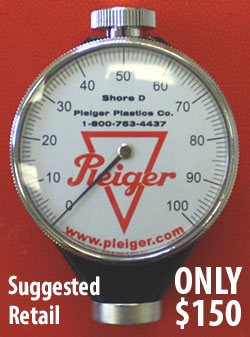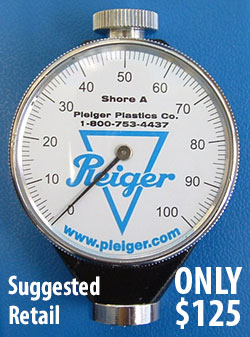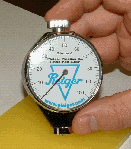A durometer gauge measures the hardness of an elastomer, similar to Rockwell hardness for steel. A durometer is a measure of indentation of a shaped pin into the elastomer surface at a given load. Shore A, D, and 00 are the most commonly used scales; however, other scales such as B, C, and O are occasionally used.
Durometer is one of the most critical properties to consider when selecting suitable polyurethane for durability and abrasion characteristics. The higher the durometer gauge number on each scale, the harder the urethane. Harder durometers exhibit better mechanical properties and better abrasion and chemical resistance than softer durometers.
Durometer Comparison Chart
| For comparison purposes only. Do not use as a conversion chart. | ||||||||||||||||||||||
|---|---|---|---|---|---|---|---|---|---|---|---|---|---|---|---|---|---|---|---|---|---|---|
| Shore A | 10 | 20 | 30 | 40 | 50 | 60 | 70 | 80 | 90 | 100 | ||||||||||||
| Shore D | 10 | 20 | 30 | 40 | 50 | 60 | 70 | 80 | 90 | 100 | ||||||||||||
| Shore OO | 10 | 20 | 30 | 40 | 50 | 60 | 70 | 80 | 90 | 100 | ||||||||||||

Durometer Gauge
The Essential Urethane Quality Control Tool
Next to material selection, the durometer gauge is one of the most critical aspects of urethane performance. Durometer can be directly linked to most performance problems and service life reduction issues. For this reason, we recommend urethane durometer be included in any quality control program.
Durometer will also play a significant role in abrasion resistance, compression set, tensile and tear strength, resiliency, and chemical resistance of urethanes. Pleiger Plastics Company manufactures polyurethanes in five-point durometer increments to provide each specific application with the best choice of hardness.
Shore A is most accurate between 20A and 90A; harder durometers use the D scale, and softer durometers use the 00 scales.


Using Your Durometer Guage
While using a durometer gauge may appear simple, a technique is required to get accurate and meaningful test results. Before attempting to test specimens with irregular surfaces, it is recommended to practice with your durometer gauge on the flat surface of a known sample. For best results, your specimen should be at least 1/4-inch thick with a room temperature of 70°F. One technique to use for practice is holding your durometer gauge on a flat glass or steel surface; the durometer should indicate 100A. If you are unsure about your durometer gauge’s function, please contact us at 1-800-PLEIGER.
Place the specimen on a firm flat surface. Hold the durometer vertically with the presser foot on the edge.
Gently roll the durometer and stand it upright, so the pressure foot rests flat on the specimen surface.



